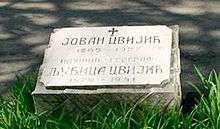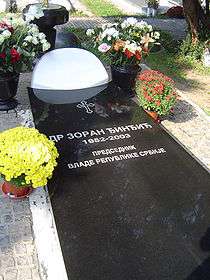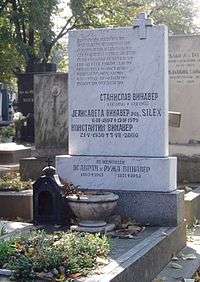Belgrade New Cemetery
|
Church of St. Nicholas at the cemetery | |
| Details | |
|---|---|
| Established | 1886 |
| Location | Zvezdara, Belgrade |
| Country | Serbia |
| Type | Christian |
The New Cemetery (Serbian: Novo groblje/Ново гробље) is a cemetery complex in Belgrade, Serbia. It is located in Ruzveltova street in Zvezdara municipality. The cemetery was built in 1886 as the third Christian cemetery in Belgrade.
Except for the graves of ordinary citizens, the cemetery complex also includes special parts: military graves from Serbian-Ottoman War (1876-1877), Serbo-Bulgarian War, Balkan Wars and World Wars, the Alley of the Greats and Alley of Distinguished Citizens, where some of the most important persons of Serbian history are buried.
History
Vladanovac
As the city expanded, Belgrade’s old cemetery at Tašmajdan became inadequate. One the one side, it became too small for the function of the city’s main graveyard. On the other, once projected to be on the outskirts of the city, as Belgrade grew, Tašmajdan practically became downtown and close to the Royal court. As the city was in the financial crisis at the time and wasn’t able to buy such a large lot for the new cemetery, mayor of Belgrade Vladan Đorđević donated a patch of his land to the city for the purpose of establishing a new cemetery. In the next decades, the area, including the graveyard itself was known as the Vladanovac, after the mayor, but gradually was replaced with the name New Cemetery.[1][2]
Period prior to 1945
New cemetery was charted into the city plans in 1884. First burials were held in 1886, but reinterment of the remains from the Tašmajdan dragged on in the several decades, being finished only in 1927. The newly developed cemetery had no chapel or church, so by the endowment of Draginja and Stanojlo Petrović, a church dedicated to Saint Nicholas, projected by the architect Svetozar Ivačković was built in 1893. First memorial monument was built in 1907, when remains of the Serbian soldiers who died in wars against the Turks and Bulgarians in the 19th century were reinterred from the Tašmajdan. During the bombardment of Belgrade in the World War I, cemetery was damaged in 1915. In 1931 Valery Vladimirovich Stashevsky projected Iverskaya chapel, a replica of the original chapel which existed in the Moscow Kremlin which the Bolsheviks demolished that same year (it was rebuilt in 1994-95).In the Interbellum, seven military graveyards were also formed so as The Monument and Memorial Ossuary to the Defenders of Belgrade 1914-1918.[1]
Period after 1945
Cemetery of Belgrade Liberators, for the soldiers who died in 1944, extension across the Ruzveltova street to the west, was built in 1954. In 1959, a memorial cemetery for all the fallen fighters of the World War II was built by the architects Bogdan Bogdanović and Svetislav Ličina. Ličina also projected the Alley of Distinguished Citizens in 1965. By the 1983 decision of the National Assembly of Serbia, the New Cemetery was declared as the cultural monument of great importance.[1]
Today
The first burials on the cemeteries that still exist today in the Belgrade's territory, were held in Zemun, at the end of the 18th century. However, the New Cemetery was the first which has been planned and projected specifically for this purpose, with all the infrastructure needed, so it is today considered to be the oldest of Belgrade's cemeteries. Among the headstones, there are 1,597 which are works of art by eminent Serbian sculptures, thus the cemetery is considered as the "museum on the open".[1]
The complex
Military graveyards
The oldest memorial at Novo groblje complex is the Serbian soldiers' ossuary built in 1907 which contains remains of the soldiers of Serbian-Ottoman War and Serbo-Bulgarian War that were transferred from Tašmajdan cemetery.[3] Another important part of the complex are the military graveyards with the remains of soldiers from Balkan Wars and World Wars. It contains remains of Serbian and other Allied soldiers, as well as Axis soldiers (there are French,[3][4] Russian,[4] British,[5][6] Italian,[3] German, Austro-Hungarian[4] and Bulgarian[4] military graveyards).[7] The complex of military graveyards also includes graves of those died in the 1941 and 1944 Bombing of Belgrade.
Cemetery of Belgrade Liberators
Part of the Novo groblje complex, but on the other side of the street from the main part is the Cemetery of Belgrade Liberators (Гробље ослободилаца Београда / Groblje oslobodilaca Beograda).[7] It contains graves of 2,944 National Liberation Army soldiers and 961 Red Army soldiers and the mass grave of 1,381 National Liberation Army soldiers and 711 Red Army soldiers who died during the Belgrade Offensive.
The cemetery includes Liberators of Belgrade memorial with the relief by sculptor Rade Stanković and the Red Army soldier sculpture by Antun Augustinčić. In front of the memorial is the sculpture of a Partisan holding a gun by Rade Stanković.
Jewish cemetery
Next to the Cemetery of Liberators is the Jewish cemetery with the remains of Jewish soldiers who died in the Balkan Wars and World War I, ossuary of Jewish refugees from Austria and the Memorial to the Holocaust victims and Jewish soldiers died in World War II by the architect Bogdan Bogdanović.[3]
Alley of the Greats

Alley of the Greats (Serbian: Алеја великана / Aleja velikana) was created in the 19th century with move of the greats from the Tašmajdan Cemetery to the New Cemetery. It was formed in 1927, with 22 places for the tombs. Some of the people buried at the Alley of the Greats are:
- Kornelije Stanković (1831–1865), composer[8]
- Ilija Milosavljević Kolarac (1789–1878), donator[9]
- Stevan Kaćanski (1828–1890), poet[10]
- Petar Kočić (1877–1916), writer[11]
- Jovan Cvijić (1865–1927), geographer[12]
- Kosta Hristić (1852–1927), diplomat and writer[13]
- Slobodan Jovanović http://www.novosti.rs/vesti/beograd.74.html:357067-Beograd-Slobodan-Jovanovic-sahranjen-u-Aleji-zasluznih-gradjana (1869–1958)
- Stevan Hristić (1885–1958), composer[14]
- Svetozar Gligorić (1923-2012), chess player.
Alley of Distinguished Citizens

Alley of Distinguished Citizens (Serbian: Алеја заслужних грађана / Aleja zaslužnih građana) was formed in 1965,[3] and that alley is used since then for the distinguished and important citizens burial, after special procedure and approval of the City Assembly of Belgrade and Mayor of Belgrade. It contains single and group tombs of important writers, artists, actors, generals, people's heroes and other important persons. Some of the people buried at the Alley of Distinguished Citizens are:[15]
- Paja Jovanović, (1859–1957), painter
- Radivoj Korać, (1938–1969), basketball player
- Petar Lubarda, (1907–1974), painter
- Mija Aleksić, (1923–1995), actor
- Ivo Andrić,[16] (1892–1975), writer, and Nobel Prize winner
- Miloš Crnjanski, (1893–1977), poet, author, and a diplomat
- Rastko Petrović, (1898–1949), poet, literary critic, art critic, author and diplomat
- Veljko Vlahović, (1914–1975), politician, Order of the National Hero bearer
- Ivan Stambolić, (1936–2000), politician
- Ljubinka Bobić, (1897–1978), actress
- Dušan Radović, (1922–1984), journalist and writer
- Branko Ćopić, (1915–1984), writer
- Zoran Radmilović, (1933–1985), actor
- Danilo Kiš, (1935–1989), writer
- Slobodan Marković, (1928–1990), poet
- Vasko Popa, (1922–1991), poet
- Borislav Pekić, (1930–1992), writer
- Dragomir Brajković, (1947–2009), writer
- Milić od Mačve, (1934–2000), painter
- Zoran Đinđić,[17] (1952–2003), Prime Minister of Serbia
- Stevo Žigon, (1926–2005), actor
- Nikola Ljubičić, (1916–2005), general, Order of the National Hero bearer, President of Serbia
- Ljuba Tadić, (1929–2005), actor
- Nenad Bogdanović, (1954–2007), Mayor of Belgrade
- Milenko Zablaćanski, (1955–2008), actor
- Meša Selimović (1910–1982), writer[18]
Gallery
References
- 1 2 3 4 Dimitrije Bukvić (28 October 2012), "Obnova najstarijeg groblja u prestonici", Politika (in Serbian)
- ↑ Dragan Perić (23 April 2017), "Šetnja pijacama i parkovima", Politika-Magazin No 1021 (in Serbian), pp. 28–29
- 1 2 3 4 5 NEW CEMETERY Archived July 7, 2009, at the Wayback Machine., Turistički vodič kroz Beograd
- 1 2 3 4 "Archived copy". Archived from the original on 2010-04-13. Retrieved 2009-10-25.
- ↑ "Casualty details—Clinton, Walter". Commonwealth War Graves Commission. Retrieved 1 November 2009.
- ↑ "Casualty details—Jovanovic, Ratko G.". Commonwealth War Graves Commission. Retrieved 1 November 2009.
- 1 2 VOJNIČKA GROBLJA > Oltari sebičnih otadžbina, Vreme, 22 April 2004 (retrieved: 22 October 2009) (in Serbian)
- ↑ Novo groblje official site: Kornelije Stanković
- ↑ Novo groblje official site: Ilija Kolarac Milosavljević
- ↑ Novo groblje official site: Stevan Kaćanski
- ↑ Novo groblje official site: Petar Kočić
- ↑ Novo groblje official site: Jovan Cvijić
- ↑ Novo groblje official site: Kosta Hristić
- ↑ Novo groblje official site: Stevan Hristić
- ↑ List of notable people buried at New Cemetery, Official cemetery website Archived October 18, 2009, at the Wayback Machine.
- ↑ "Ivo Andrić". Official website of Novo Groblje. Archived from the original on 2009-10-19. Retrieved 2009-10-24.
- ↑ "Zoran Đinđić". Official website of Novo Groblje. Archived from the original on 2009-10-19. Retrieved 2009-10-24.
- ↑ http://www.klix.ba/vijesti/kultura/na-danasnji-dan-nepokretan-i-nijem-umro-je-veliki-pisac-mesa-selimovic/140711004
External links
| Wikimedia Commons has media related to Novo groblje Beograd. |
- Novo groblje
- Novo groblje sa Alejom velikana at [www.ANTIC.org] (in Serbian)
- Nenad Bogdanović will not sign decision about Slobodan Milošević burial in the Alley of Distinguished Citizens, 13. Mart 2006. (in Serbian)
- Ljuba Tadić buried in the Alley of Distinguished Citizens (in Serbian)
- Mayor of Belgrade Nenad Bogdanović buried in the New Cemetery, 30. September 2007. (in Serbian)
- CWGC: Belgrade new cemetery
- Novo groblje u Beogradu, RTS, 4 September 2009
Coordinates: 44°48′34″N 20°29′14″E / 44.80944°N 20.48722°E














